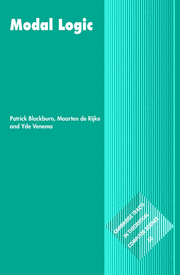Book contents
- Frontmatter
- Dedication
- Contents
- Preface
- 1 Basic Concepts
- 2 Models
- 3 Frames
- 4 Completeness
- 5 Algebras and General Frames
- 6 Computability and Complexity
- 7 Extended Modal Logic
- Appendix A A Logical Toolkit
- Appendix B An Algebraic Toolkit
- Appendix C A Computational Toolkit
- Appendix D A Guide to the Literature
- References
- List of Notation
- Index
1 - Basic Concepts
Published online by Cambridge University Press: 05 July 2014
- Frontmatter
- Dedication
- Contents
- Preface
- 1 Basic Concepts
- 2 Models
- 3 Frames
- 4 Completeness
- 5 Algebras and General Frames
- 6 Computability and Complexity
- 7 Extended Modal Logic
- Appendix A A Logical Toolkit
- Appendix B An Algebraic Toolkit
- Appendix C A Computational Toolkit
- Appendix D A Guide to the Literature
- References
- List of Notation
- Index
Summary
Languages of propositional modal logic are propositional languages to which sentential operators (usually called modalities or modal operators) have been added. In spite of their syntactic simplicity, such languages turn out to be useful tools for describing and reasoning about relational structures. A relational structure is a non-empty set on which a number of relations have been defined; they are widespread in mathematics, computer science, artificial intelligence and linguistics, and are also used to interpret first-order languages.
Now, when working with relational structures we are often interested in structures possessing certain properties. Perhaps a certain transitive binary relation is particularly important. Or perhaps we are interested in applications where ‘dead ends,’ ‘loops,’ and ‘forkings’ are crucial, or where each relation is a partial function. Wherever our interests lie, modal languages can be useful, for modal operators are essentially a simple way of accessing the information contained in relational structures. As we will see, the local and internal access method that modalities offer is strong enough to describe, constrain, and reason about many interesting and important aspects of relational structures.
Much of this book is essentially an exploration and elaboration of these remarks. The present chapter introduces the concepts and terminology we will need, and the concluding section places them in historical context.
Chapter guide
Section 1.1: Relational Structures. Relational structures are defined, and a number of examples are given.
Section 1.2: Modal Languages. We define the basic modal language and some of its extensions.
- Type
- Chapter
- Information
- Modal Logic , pp. 1 - 49Publisher: Cambridge University PressPrint publication year: 2001
- 1
- Cited by



